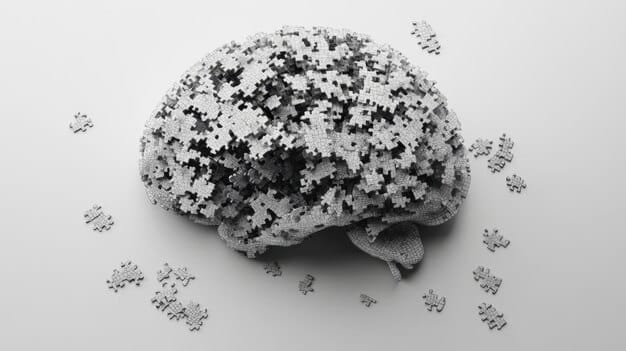Understanding Trauma’s Impact on Mental Health: PTSD and Support

Trauma significantly impacts mental health, potentially leading to post-traumatic stress disorder (PTSD); understanding this impact and finding adequate support is crucial for recovery and improved well-being.
The Impact of Trauma on Mental Health: Understanding PTSD and Finding Support is a critical subject that deserves attention, as trauma can profoundly affect one’s mental well-being. Understanding the effects of trauma and knowing how to seek help are vital steps toward healing and recovery.
Understanding the Nature of Trauma
Trauma isn’t simply a stressful event; it’s a deeply distressing or disturbing experience that overwhelms an individual’s ability to cope, leaving lasting adverse effects on their mental, physical, social, emotional, and spiritual well-being. Let’s explore what constitutes trauma and how it differs from everyday stress.
Defining Psychological Trauma
Psychological trauma results from events that overwhelm a person’s capacity to cope. These events can be singular, like an accident or assault, or prolonged, like ongoing abuse or neglect. It’s essential to recognize trauma’s subjective nature; what is traumatic for one person may not be for another.
Types of Traumatic Events
Traumatic events can encompass a wide range of experiences, including:
- Natural disasters like hurricanes, earthquakes, and floods.
- Accidents involving severe injury or the threat of death.
- Violent personal assaults, such as robbery, rape, or domestic violence.
- War and combat experiences.
Recognizing these events as potential sources of trauma is the first step in understanding their impact.
Trauma involves experiences that overwhelm our normal coping mechanisms, leaving behind painful emotional and psychological scars. By acknowledging the various forms trauma can take, we can start to identify its potential effects on mental health.

The Impact of Trauma on the Brain
Trauma changes the brain; it can affect how we process information, regulate emotions, and interact with the world around us. Understanding the neuroscience behind trauma helps illuminate the challenges faced by those who have experienced it. Let’s delve into the specific brain regions affected by trauma and their related functions.
The Amygdala’s Role
The amygdala, responsible for processing emotions, particularly fear, becomes hyperactive after trauma. This heightened activity can lead to increased anxiety, panic attacks, and a constant state of alertness, often referred to as hypervigilance.
The Hippocampus and Memory
The hippocampus, critical for memory formation, can be impaired by trauma. This impairment may result in difficulty distinguishing between past and present, leading to flashbacks and intrusive memories that feel like they are happening in real-time.
- Reduced ability to contextualize memories accurately.
- Difficulty forming new memories after the traumatic event.
- Fragmented or disorganized recall of the traumatic event itself.
These neurological changes illustrate why trauma is not simply an emotional experience but a physical one, profoundly affecting the brain’s architecture.
Trauma’s impact on the brain is multifaceted, altering emotional regulation and memory processing. Recognizing these neurological changes is crucial for developing effective treatments and therapies.
Post-Traumatic Stress Disorder (PTSD): Understanding the Condition
Post-traumatic stress disorder, or PTSD, is a mental health condition that some people develop after experiencing or witnessing a traumatic event. It’s characterized by a specific set of symptoms that can significantly impair daily functioning. Let’s examine the diagnostic criteria for PTSD and understand how it differs from normal stress responses.
Diagnostic Criteria for PTSD
According to the Diagnostic and Statistical Manual of Mental Disorders (DSM-5), PTSD diagnosis requires exposure to actual or threatened death, serious injury, or sexual violence. Additionally, individuals must exhibit symptoms from four main categories:
- Intrusion symptoms, such as recurrent, involuntary, and distressing memories.
- Avoidance symptoms, including efforts to avoid thoughts, feelings, or reminders of the trauma.
- Negative alterations in cognitions and mood, such as persistent negative beliefs about oneself or the world.
- Alterations in arousal and reactivity, like irritability, reckless behavior, or hypervigilance.
Distinguishing PTSD from Normal Stress Responses
While it’s normal to experience distress after a traumatic event, PTSD is marked by the persistence and severity of symptoms that interfere with daily life. Unlike typical stress responses, PTSD symptoms often intensify over time if left untreated.
Understanding the diagnostic criteria and distinguishing PTSD from normal stress responses is essential for accurate diagnosis and appropriate treatment. PTSD is a serious condition that requires professional intervention.

Effective Treatment Options for PTSD
Fortunately, effective treatments are available for PTSD, offering hope and relief to those who struggle with its symptoms. Evidence-based therapies and medication can significantly improve quality of life. Let’s explore some of the most effective treatment options.
Psychotherapy Techniques
Several psychotherapy techniques have proven effective in treating PTSD:
- Cognitive Behavioral Therapy (CBT): Helps individuals identify and change negative thought patterns and behaviors associated with trauma.
- Eye Movement Desensitization and Reprocessing (EMDR): Facilitates the processing of traumatic memories through guided eye movements and cognitive techniques.
- Prolonged Exposure (PE) Therapy: Involves gradually exposing individuals to trauma-related memories and situations to reduce fear and avoidance.
Medication Options
Medications, particularly selective serotonin reuptake inhibitors (SSRIs) and serotonin-norepinephrine reuptake inhibitors (SNRIs), can help manage symptoms of PTSD, such as depression, anxiety, and insomnia. These medications work by regulating neurotransmitter levels in the brain.
Effective treatment options such as psychotherapy and medication offer significant relief for those with PTSD. Seeking professional help is a critical step toward recovery.
Building Resilience After Trauma
Building resilience after trauma involves developing strategies and coping mechanisms that promote healing and growth. It’s about finding ways to navigate challenges and thrive despite past experiences. Let’s discuss practical strategies for fostering resilience and promoting recovery.
Developing Coping Strategies
Effective coping strategies can help individuals manage distressing emotions and regain a sense of control:
- Mindfulness practices, such as meditation and deep breathing exercises.
- Engaging in physical activity to release tension and improve mood.
- Maintaining a healthy diet and sleep routine.
- Connecting with supportive friends and family members.
Seeking Social Support
Social support is a crucial component of resilience. Connecting with others who understand and validate your experiences can provide a sense of belonging and reduce feelings of isolation. Support groups, therapy groups, and online communities can offer valuable connections and resources.
Building resilience after trauma involves developing coping strategies and seeking social support. These steps can lead to healing and growth, transforming trauma into an opportunity for self-discovery and empowerment.
The Role of Support Systems in Healing
Support systems play a pivotal role in the healing process after trauma. Friends, family, therapists, and support groups can provide essential emotional, practical, and informational support. Let’s understand how to foster healthy relationships and seek help when needed.
Fostering Healthy Relationships
Healthy relationships are characterized by:
- Mutual respect and trust.
- Open and honest communication.
- Empathy and validation.
- Boundaries that protect emotional well-being.
Accessing Professional Help
Knowing when to seek professional help is crucial for recovery. Signs that professional intervention may be necessary include:
- Persistent symptoms of anxiety, depression, or PTSD.
- Difficulty managing daily tasks or maintaining relationships.
- Thoughts of self-harm or suicide.
Remember, seeking help is a sign of strength, not weakness.
Support systems are vital for healing after trauma, offering emotional, practical, and informational support. Nurturing healthy relationships and seeking professional help when needed are essential steps towards recovery.
| Key Aspect | Brief Description |
|---|---|
| 🧠 Trauma’s Impact | Trauma changes brain function, impacting emotions and memory. |
| ⚠️ PTSD Symptoms | Includes intrusion, avoidance, negative thoughts, and hyperarousal. |
| 🛡️ Effective Treatments | Psychotherapy (CBT, EMDR) and medication can significantly help. |
| 🤝 Seeking Support | Healthy relationships and professional help are crucial for healing. |
Frequently Asked Questions
▼
A traumatic event is any deeply distressing or disturbing experience that overwhelms an individual’s ability to cope, such as accidents, assaults, or natural disasters.
▼
Trauma can alter the brain’s structure and function, particularly in areas responsible for emotions and memory, leading to increased anxiety and difficulty processing memories.
▼
The main symptoms include intrusive memories, avoidance of reminders, negative thoughts and feelings, and heightened arousal, such as irritability or hypervigilance.
▼
Effective treatments include psychotherapy techniques like CBT and EMDR, as well as medications like SSRIs and SNRIs to manage symptoms such as anxiety and depression.
▼
You can build resilience by developing coping strategies like mindfulness, seeking social support, and fostering healthy relationships to promote healing and personal growth.
Conclusion
Understanding the impact of trauma on mental health, particularly in the context of PTSD, is essential for promoting healing and recovery. By recognizing the signs and symptoms, seeking appropriate treatment, and building strong support systems, individuals can navigate the challenges of trauma and lead fulfilling lives. Remember, help is available, and recovery is possible.





